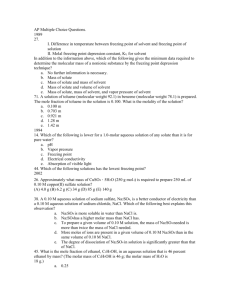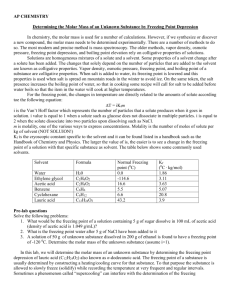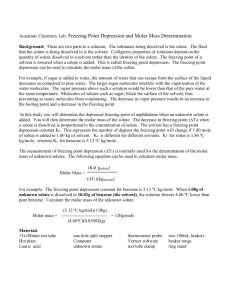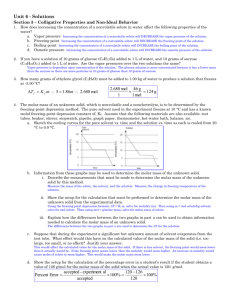CH 222 Freezing Point Depression
advertisement
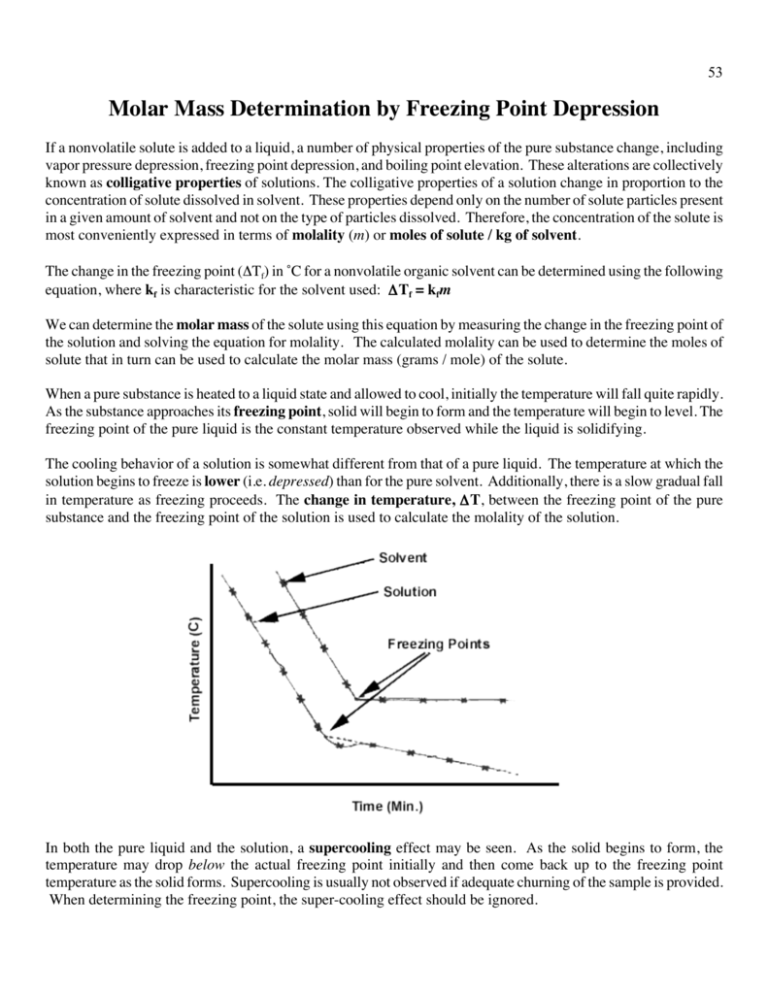
53 Molar Mass Determination by Freezing Point Depression If a nonvolatile solute is added to a liquid, a number of physical properties of the pure substance change, including vapor pressure depression, freezing point depression, and boiling point elevation. These alterations are collectively known as colligative properties of solutions. The colligative properties of a solution change in proportion to the concentration of solute dissolved in solvent. These properties depend only on the number of solute particles present in a given amount of solvent and not on the type of particles dissolved. Therefore, the concentration of the solute is most conveniently expressed in terms of molality (m) or moles of solute / kg of solvent. The change in the freezing point (ΔTf) in ˚C for a nonvolatile organic solvent can be determined using the following equation, where kf is characteristic for the solvent used: ΔTf = kfm We can determine the molar mass of the solute using this equation by measuring the change in the freezing point of the solution and solving the equation for molality. The calculated molality can be used to determine the moles of solute that in turn can be used to calculate the molar mass (grams / mole) of the solute. When a pure substance is heated to a liquid state and allowed to cool, initially the temperature will fall quite rapidly. As the substance approaches its freezing point, solid will begin to form and the temperature will begin to level. The freezing point of the pure liquid is the constant temperature observed while the liquid is solidifying. The cooling behavior of a solution is somewhat different from that of a pure liquid. The temperature at which the solution begins to freeze is lower (i.e. depressed) than for the pure solvent. Additionally, there is a slow gradual fall in temperature as freezing proceeds. The change in temperature, ΔT, between the freezing point of the pure substance and the freezing point of the solution is used to calculate the molality of the solution. In both the pure liquid and the solution, a supercooling effect may be seen. As the solid begins to form, the temperature may drop below the actual freezing point initially and then come back up to the freezing point temperature as the solid forms. Supercooling is usually not observed if adequate churning of the sample is provided. When determining the freezing point, the super-cooling effect should be ignored. 54 In this experiment, you will first determine the freezing point of a pure solvent, lauric acid (C12H24O2). Next, you will use a known solute, benzoic acid, to depress the freezing point of the solvent and calculate the molar mass of the benzoic acid. PROCEDURE: Part A: Determining the Freezing Point for Lauric Acid 1. Set up ring stand and test tube clamp beside the hot plate 2. Fill a large beaker about ¾ full with tap water and heat on hot plate. 3. Mass 10.000-12.000 g of solid lauric acid (C12H24O2) and record the mass. Add it to a large test tube. Fit a 2holed stopper over the beaker so that a looped glass rod fits through the center hole (this is your swizzle stick) and wrap the cut hole around your thermometer (see picture above, although it shows the thermometer crammed through the hole in the center which you should not do!) Also, as pictured, keep the cork above the test tube to prevent any pressure build up in the tube while heating and cooling. 4. Place test tube in the beaker and heat until the lauric acid is completely melted. Gently stir to uniformity. Do not overheat as you will need to cool it in step 7 (perhaps read ahead?) You may need to readjust your thermometer so it remains in the solution. 5. Remove the test tube from the hot water and allow it to cool. Once the temperature reaches 50 °C, begin to record the temperature every 30 seconds until the temperature plateaus for 3 minutes or reaches 35 °C. (This should take 5-10 minutes). Mix gently to maintain uniformity (test tubes are glass! Careful!) The biggest source of error in this lab is the temperature so use care in reading. Note: Be sure that data is recorded in the lab data books for all lab partners (perhaps the note keeper could record in both note books as the other student mixes?) 55 PROCEDURE: Part B: Determination of Molecular Weight of a Benzoic Acid 6. Mass 1.000 - 1.200 g of benzoic acid and record the mass. Add to the test tube with the lauric acid. Be careful not to lose any sample of lauric acid that may have solidified to the thermometer or swizzle stick. 7. Place test tube in hot water and melt the mixture, stirring to uniformity. 8. Remove the test tube from the hot water and allow it to cool. Once the temperature reaches 50 °C, begin to record the temperature every 30 seconds until the temperature plateaus for 3 minutes or reaches 35 °C. (This should take 5-10 minutes). Mix gently to maintain uniformity (test tubes are glass! Careful!) 9. Repeat steps 6 through 8, adding an additional 1.000 - 1.200 grams of benzoic acid to the solution. Do NOT make a new solution! 10. Time to clean up! To clean up, re-melt your solid and pour into waste container. You may need to add a tiny bit of hot water along the sides of the tube to help melt the solid. Wipe the thermometer and swizzle stick with a wee bit of acetone if needed. 56 CALCULATIONS: Determining the Molar Mass of the Unknown Solute Once you have completed your experiment, you will need to create a graph in Excel (or a similar program; no hand drawn graphs will be accepted.) Use time as the x-axis and temperature as the y-axis. Plot the data from your pure lauric acid experiment (Part A) and also the data from each of the benzoic acid solutions (Part B) using the same graph. Label the axes and use different colors and/or marking symbols to distinguish the trials. Determine the freezing point for each trial graphically; draw a circle on your graph representing the freezing point in each trial. The kf value for lauric acid is 3.90 °C/m. Using the data from Part A and Part B, calculate the molar mass of benzoic acid in each trial. Show how you calculated these values in your lab report. Average the two molar mass values and calculate the parts per thousand. Using the Internet or a textbook, determine the structure of benzoic acid and include a Lewis structure for benzoic acid in your lab report. (Hand drawn Lewis structures are ok.) Determine the actual molar mass of benzoic acid using the Lewis structure. Calculate the percent error of benzoic acid using your average molar mass value and the accepted molar mass value. POSTLAB QUESTIONS: 1. Determine the effect of the following on the final molar mass calculation. Give your reasoning. Tell if the molar mass will be higher, lower or not change. a. The thermometer you were using read temperatures consistently 1.2 ˚C higher than the real temperature. b. You added 3 g of unknown solute during your freezing point determination. c. In adding your unknown solute to your cyclohexane, you spilled some into your water bath. 2. A student performs a freezing point analysis. She determines that the freezing point of 21.00 g of stearic acid (where kf = 4.89°C/m) is 68.20 ˚C. She adds 2.07 grams of an unknown compound to her sample and determines the freezing point to be 65.53 ˚C. She adds an additional 1.97 g of the unknown compound and determines the new freezing point to be 63.03 ˚C. a. Determine the molar mass of the unknown compound using the 2.07 g of sample. b. Determine the molar mass of the unknown compound using the combined samples (hint: 2.07 + 1.97 = 4.04 g total solute) c. Determine the average molar mass of the compound and the parts per thousand for the two trials.





